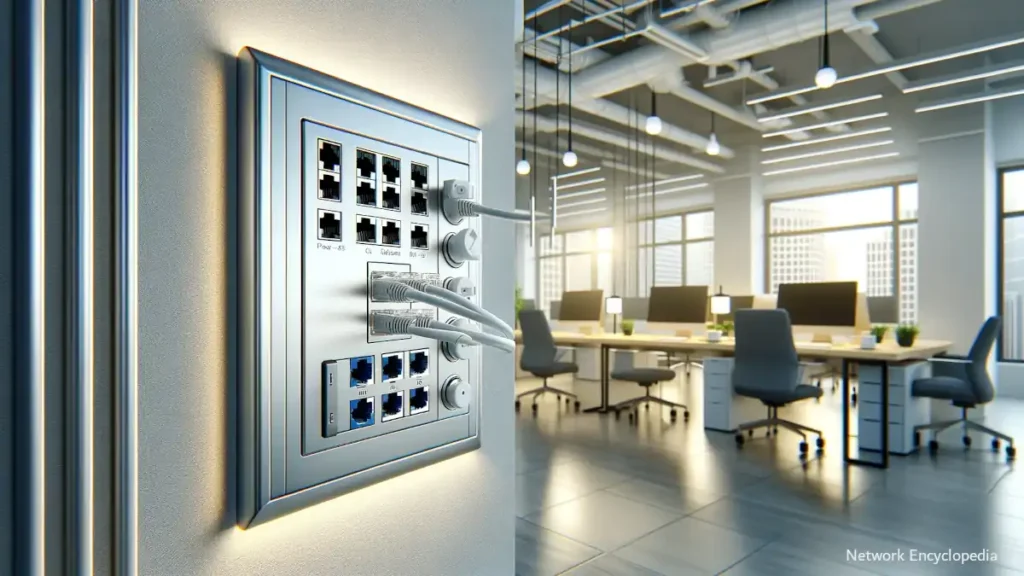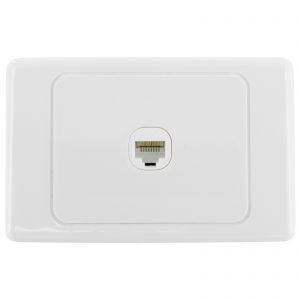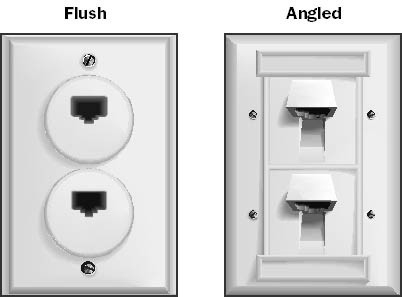In the realm of networking infrastructure, wall plates stand as a fundamental component that bridges the aesthetic and functional aspects of network installations. They not only facilitate a neat and organized way to present network connections within buildings but also play a crucial role in safeguarding the physical integrity of cables. This comprehensive article delves into the intricacies of wall plates, covering their types, importance, and installation processes, thereby offering a holistic understanding of their role in networking.
Table of Contents:
- What is a Wall Plate?
- Types of Wall Plates
- The Importance of Wall Plates
- Identifying Wall Plates
- Specialized Wall Plates
- Installing a Wall Plate: A Step-by-Step Guide for RJ-45 Wall Plate
- What is a Faceplate?
- Conclusion

1. What is a Wall Plate (in computer networking)?
A wall plate in networking is a rectangular, square, or sometimes circular plate that fits into or onto a wall or furniture, providing a clean, accessible interface for network cables. These plates host connectors like RJ-45, coaxial, or fiber optic ports, enabling devices to connect to a building’s network infrastructure seamlessly. Wall plates are pivotal in creating a permanent and aesthetically pleasing access point for internet and communication services.

The back end of the connector joins a horizontal cable that runs inside the wall or through a false ceiling or floor to a patch panel in the wiring closet for that floor. Computers are then connected to the wall plate by a short unshielded twisted-pair (UTP) cable called a drop cable. Wall plates typically come in mono-port, dual-port, and quad-port configurations.
2. Types of Wall Plates
The diversity in wall plate designs reflects the myriad requirements of networking installations. Below are the primary types:
Flush Wall Plates
Flush wall plates are designed to lie flat against the wall, mirroring the appearance of AC outlets. Their sleek design is preferred for its minimalistic look, integrating seamlessly with the wall’s surface. Flush wall plates are widely used in environments where maintaining a discreet networking presence is essential.
Angled Wall Plates
Angled wall plates are crafted with a slight outward angle, providing an ergonomic path for cables to connect without bending excessively. This design is particularly beneficial in protecting cables from damage caused by sharp bends or heavy, sharp-edged furniture pressing against them. Angled wall plates offer an ideal solution in high-traffic areas or where furniture placement might compromise cable integrity.

3. The Importance of Wall Plates
Wall plates are not merely decorative elements; they serve essential functions in the durability and functionality of network installations:
- Protection: They protect the exposed ends of cables from physical damage, dust, and other environmental factors.
- Accessibility: Wall plates make it easier to connect and disconnect devices without accessing the main wiring infrastructure directly.
- Organization: They help in maintaining an organized and professional appearance by managing and concealing cables effectively.
4. Identifying Wall Plates
Proper identification of wall plates is crucial for efficient network management. Labeling or numbering wall plates corresponding to their connected port on the patch panel simplifies troubleshooting, maintenance, and future upgrades. This practice ensures a straightforward way to locate and address connectivity issues or reconfigure network setups as needed.
5. Specialized Wall Plates
Fiber Wall Plate
A fiber wall plate is specifically designed for terminating and connecting fiber optic cables. It is an essential component in modern telecommunications and networking, offering a high-speed connection point that is crucial for data centers, office buildings, and residences relying on fiber optic infrastructure.
Coaxial Wall Plate
Coaxial wall plates are tailored for coaxial cable connections, commonly used in television and internet services. These wall plates enable the connection of devices to broadband networks or satellite/cable TV services, providing a dedicated port for coaxial cables.
Wall Plates for Serial Interfaces
In environments where serial connections are necessary, specialized wall plates with DB9 or DB25 connectors are available. These wall plates facilitate connections to devices requiring serial communication, such as older computer systems, industrial machinery, or point-of-sale terminals.
6. Installing a Wall Plate: A Step-by-Step Guide for RJ-45 Wall Plate
Tools and Materials
Before beginning the installation, ensure you have the following:
- RJ-45 wall plate kit
- Ethernet cable
- Punch down tool
- Screwdriver
- Drywall saw or a low-voltage mounting bracket (optional)
Installation Process
- Prepare the Site: If installing into drywall without an existing outlet, mark the area where the wall plate will go. Use a drywall saw to cut out the marked area carefully.
- Run the Cable: Route the Ethernet cable from the network’s central hub or switch to the location of the wall plate. Ensure there’s enough slack for easy connection.
- Secure the Wall Plate Bracket: If using a mounting bracket, insert it into the cutout, following the manufacturer’s instructions to secure it in place.
- Terminate the Cable: Strip the outer sheath of the Ethernet cable, untwist the pairs, and arrange them according to the T568A or T568B wiring standard. Use a punch down tool to secure the wires into the RJ-45 jack’s terminals.
- Attach the Wall Plate: Once the RJ-45 jack is prepared, attach it to the wall plate (if not already pre-installed). Then, secure the wall plate to the wall or mounting bracket with screws.
- Test the Connection: Before concluding the installation, test the connection with a network cable tester to ensure proper wiring and connectivity.
Tips and Tricks
- Always double-check the wiring standard (T568A or T568B) you’re using and ensure consistency throughout the network.
- Leave a service loop (extra cable) behind the wall plate for future adjustments or re-terminations.
- Use a level tool when installing the mounting bracket to ensure the wall plate sits straight.
7. What is a Faceplate?
In the context of networking and telecommunications, a faceplate is synonymous with a wall plate, often used interchangeably. It refers to the exterior part of the outlet that provides access to network or telephone system connections. The term “faceplate” emphasizes the part of the outlet visible on the wall or furniture surface, hosting one or more ports for cable connection.
8. Conclusion
Wall plates are a vital component in the structured cabling ecosystem, offering protection, organization, and accessibility for network installations. Understanding the different types of wall plates and their specific uses allows for tailored solutions that meet the aesthetic and functional needs of any space. Proper identification and correct installation are key to leveraging the full benefits of wall plates, ensuring a reliable and efficient networking infrastructure. Whether for fiber optic, coaxial, or Ethernet connections, choosing the right wall plate is instrumental in creating a seamless, high-performing network environment.